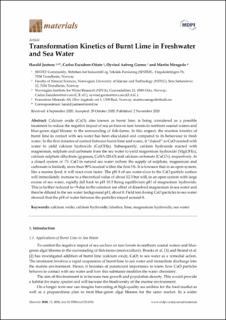| dc.description.abstract | Calcium oxide (CaO), also known as burnt lime, is being considered as a possible treatment to reduce the negative impact of sea urchins on tare forests in northern coastal waters and blue-green algal blooms in the surrounding of fish-farms. In this respect, the reaction kinetics of burnt lime in contact with sea water has been elucidated and compared to its behaviour in fresh water. In the first minutes of contact between burnt lime and water, it “slaked” as CaO reacted with water to yield calcium hydroxide (Ca(OH)2). Subsequently, calcium hydroxide reacted with magnesium, sulphate and carbonate from the sea water to yield magnesium hydroxide (Mg(OH)2), calcium sulphate dihydrate (gypsum, CaSO4·2H2O) and calcium carbonate (CaCO3), respectively. In a closed system of 1% CaO in natural sea water (where the supply of sulphate, magnesium and carbonate is limited), more than 90% reacted within the first 5 h. It is foreseen that in an open system, like a marine fjord, it will react even faster. The pH 8 of sea water close to the CaO particle surface will immediately increase to a theoretical value of about 12.5 but will, in an open system with large excess of sea water, rapidly fall back to pH 10.5 being equilibrium pH of magnesium hydroxide. This is further reduced to <9 due to the common ion effect of dissolved magnesium in sea water and then be diluted to the sea water background pH, about 8. Field test dosing CaO particles to sea water showed that the pH of water between the particles stayed around 8. | en_US |

